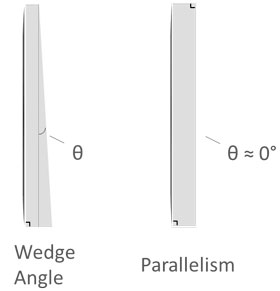Mechanical Dimensions
Clear Aperture (CA)
Clear aperture (CA) is defined as the dimensional area of an optical component over which the specifications must be met (Figure 1). It is usually specified in terms of diameter for round parts or length and width for square or rectangular parts.
In the case of optical filters housed in an assembly, clear aperture is dictated by the window size of the ring or housing. For unmounted filters, CA depends on whether the parts were coated to the edge, or if tooling introduced an uncoated lip around the edge of the coated surface of the part.
In most cases, a CA of greater than 90% can be achieved for unmounted optical filters. However, this value may necessarily be smaller for large format parts with challenging spectral requirements.
Parallelism and Wedge
Parallelism and wedge refer to the angle between two surfaces of an optic. Parallelism is specified as the maximum tolerance away from perfectly parallel one surface is allowed to be from a second surface or reference datum (Figure 2). It can be specified as an angle, usually in units of arcminutes or arcseconds, or as an envelope tolerance, usually in units of mm. Wedge specifications, on the other hand, are given by a desired wedge angle and a ± tolerance, usually in units of degrees.
Optical substrate manufacturers are able to achieve precision parallelism or wedge specifications by means of polishing. Because the thin-film coating has a negligible effect on these properties, wedge and parallelism specs are typically evaluated according to the substrate vendor data. The instrument used to measure parallelism and wedge will depend on the specification and can include interferometers, autocollimators, goniometers, or coordinate measurement machines.
Why Alluxa?
Alluxa’s team of experts has delivered key innovations to the field of optical thin-films. In addition to designing and constructing all of our own custom optical thin-film coating equipment, we invented a novel plasma deposition coating process that both increases the performance of our optical filters and decreases the time it takes to produce them.
By combining these innovations with state-of-the-art automation, proprietary control algorithms, and precision monitoring during the coating process, we are able to deliver low-cost, high-performance, custom thin-film optical filters for any application.




